Introduction to Facebook Advertising on CallTrackingMetrics
Are you considering running Facebook ads for your business? Even if you’re in an industry that may not typically think to target your audience on Facebook, it’s a great option for marketers across all verticals to explore. With over 2.4 billion monthly active users who, on average, regularly visit the site 8 or more times per day, Facebook has become more than a social networking site; it’s a powerful advertising machine. Facebook reports that 1.6 billion people worldwide are connected to a small business on Facebook, and in recent studies, 26% of Facebook users reported making a purchase based on an ad they saw on Facebook, and 78% of American consumers say they’ve discovered a product because of Facebook.
78% of American consumers say they’ve discovered a product because of Facebook.
As an advertiser, you also have a lot more control over your ads and targeting options on Facebook than other platforms—and, while this is starting to change, Facebook tends to be more affordable than other digital advertising platforms, like Google Ads.
Still, there’s a lot to consider in terms of setting up your Facebook ads account, and especially with tracking your ad performance and conversions from CallTrackingMetrics. Below, we’ll take you through a high-level overview of Facebook ad formats and placements, how to start running ads on Facebook, and most importantly, how to track your results in Facebook and CallTrackingMetrics.
Part I: Facebook Advertising Overview
If you use Facebook, you’ve already been exposed to ads on the platform in a variety of ways. Advertisers can choose between different formats when creating ads on Facebook, including single image, video or animated, or carousel ads, which will move through a series of single image ads.
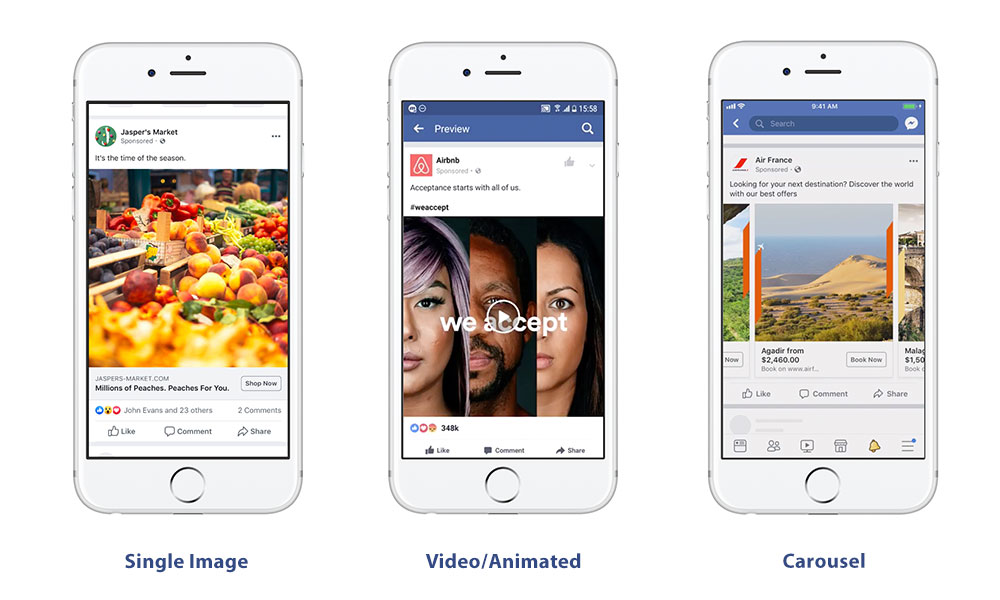
You can also customize the above based on the device your end-user is viewing on, whether it’s desktop or mobile.
In addition, Facebook offers a variety of placements for advertisements. No doubt you’ve seen ads in your Newsfeed and Stories, but you can also place ads in Facebook Marketplace and Messenger. Facebook even offers an Audience Network of external sites where you can choose to showcase your ads.

One nice feature is that you can automatically set up ads to run on both Facebook and Instagram, all within the Facebook platform. When uploading one creative, you can choose to run that creative across multiple placements at once and preview how your creative looks across each placement. We do recommend customizing the ad per placement to ensure that you get the proper wording and imaging you want no matter where it shows up—you don’t want any of your messaging to be cut off!
Tip: Aim for an 80:20 image to text ratio for your Facebook ads.
Facebook does have some rules around advertisements. Before ads show up on Facebook or Instagram, the Facebook team reviews them to ensure they abide by their policies and that your landing page functions and matches the product/service promoted in your ad. (This process can take up to 24 hours.) We suggest familiarizing yourself with all of Facebook’s advertising policies here, but one high-level thing to keep in mind when creating your ads is to avoid having too much text inside your images. Facebook suggests that you use little or no image text when possible, which can be tricky to do. Aim for an 80:20 image to text ratio to help your ads get approved and perform well on Facebook.
Part II. How to Start Running Ads on Facebook
Before you start running ads on Facebook, you need a game plan for how you want to promote your product or business and goals in place. Are you trying to build awareness for your brand and grow your community? Or are you strictly focused on driving conversions? This will inform the type of ad content you post, like whether you’re sharing educational blog content or thought leadership to generate good will with your brand, or want to push promotions to get people in the door or on your email list.
First things first, if you don’t have one already, you need a Facebook page for your business to link your ads to. Here are some instructions on how to set up a Facebook business page.
When you’re ready to create your ads, follow these steps:
- Configure Your Pixel. Install a base pixel to track events on your site as a result of Facebook advertisements. You can create custom pixel events, such as plan sign ups, Viewed Pricing Page, etc. You can also create offline conversion events to tie those back to your ads (such as inbound calls from CallTrackingMetrics).
- Choose Your Objective. When you’re creating ads on Facebook, the platform prompts you to choose an objective at the campaign level, which will ultimately be based on your unique business goals. You can select “Awareness,” which will aim to generate interest in your product or service and broaden your reach; “Consideration,” where the goal is to inspire people to actually start evaluating your business to make a purchase and do more research; and “Conversions,” which would drive people to purchase your product or service.
- Build Audiences. One of the primary benefits of advertising on Facebook is that you can get very granular in pinpointing the exact criteria to target who you’re looking to reach. You can use your own first party data, like your existing customer or lead lists, to build lookalike audiences or to retarget to site visitors (however you don’t need this in order to do retargeting). You can also build unique targeting lists based on audience behaviors and interests, like “cooking” or “technology,” which will pull from Facebook user likes and dislikes, and layer on these behaviors or interests on top of lookalike audiences to get more specific or even focus on particular locations or demographics. And while this might sound a little daunting as a consumer, rest easy knowing that even if an advertiser is targeting very specific criteria, they’ll never be able to actually access unique personal or identifying information with these audience lists.
- Set Your Budget. The budget you allocate for Facebook ads will vary depending on your unique business needs and marketing strategy, as well as other channels you choose to allocate spend. For reference, studies say that most clicks on average cost about $1.72, whereas Google Ads averages around $2 per click—these numbers can vary widely by industry, though, and can be significantly higher. When setting up your budget, you can choose to control your pacing daily (giving you ultimate oversight over your budget allocations) or to allow Facebook to optimize your budget spend over the lifetime of your ad run (typically a month or longer).
- Create Your Ad. Now it’s time to build your ad! Upload your image, customize your copy and language for your CTA (call-to-action, or where you want to direct people to from your ad), and append any tracking to your click-through URL that you want to view in Analytics or CallTrackingMetrics.
- Organize Your Ads Account. Within your account in the Facebook Ads Manager, you’ll first create your campaign, then your ad set, and finally your ad, so how you then structure and organize your ad sets and ads is really up to you! At CallTrackingMetrics, we break out our campaigns by objective (as explained above) and the ad sets by audience and tactic (such as retargeting versus lookalikes).
Part III. Tracking Your Ad Performance in Facebook and CallTrackingMetrics
Congrats, by now your ad is out in the wild! Now it’s time to monitor how it performs.
Your Facebook Business account offers its own set of valuable reporting tools, including Ads Reporting and Analytics dashboards that help you dive deeper into how users are interacting with your ads, their demographic info, how your ads are performing on a daily, weekly, or monthly basis, performance by placement, and more.
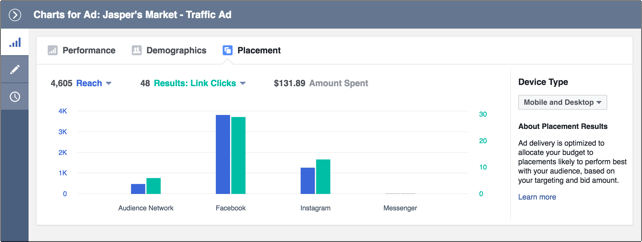
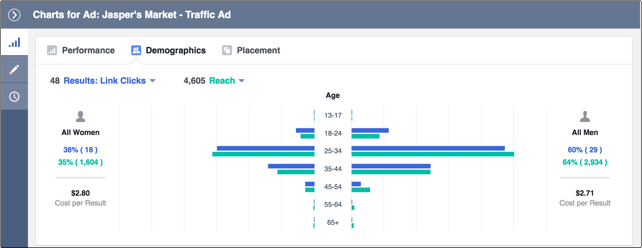
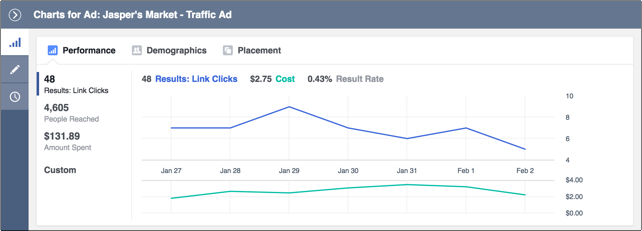
You can monitor the types of audiences you’re reaching to make sure it’s who you want to target, as well as see over time how much you’re spending on advertisements and make adjustments as needed.
To get more granular, though, and truly understand how Facebook ads are contributing to your specific leads and/or conversions, you’ll want to link CallTrackingMetrics to your Facebook Business account. Our integration with Facebook allows you to connect your activity in CallTrackingMetrics back to the original ads that users interacted with along the way, helping you build a more holistic view of your campaigns and optimize your audience targeting and ad spend by bringing CallTrackingMetrics data together with Facebook reporting.
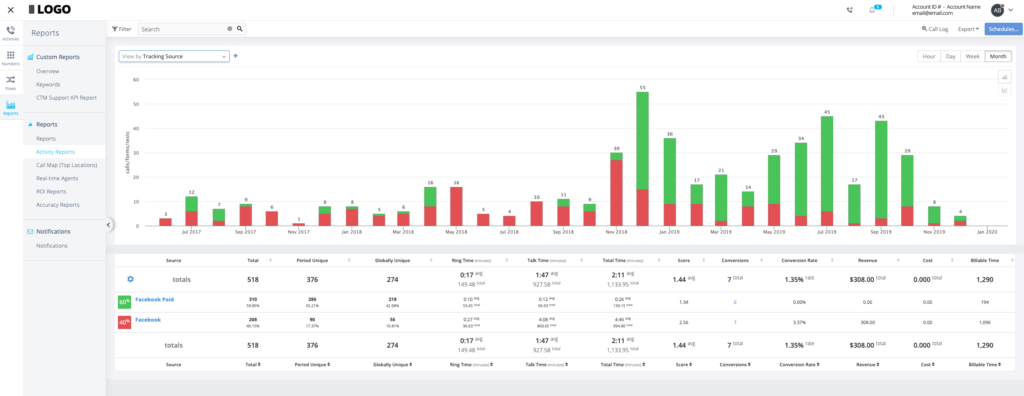
CallTrackingMetrics sends activity data—such as calls, form submissions, texts, or chats—into Facebook as offline events. You can customize, through the user of triggers, how you push activity from your call log to Facebook Ads Manager. For example, you could choose to send data from calls lasting over a certain length, or that generated sales over a set amount, so you can track how certain ads contribute towards conversions, lead or call volume, and revenue. You can also set up a tag in CallTrackingMetrics to appear whenever an incoming call comes in from a lead who clicked through one of your Facebook ads. Your CallTrackingMetrics caller data can help you build more targeted lists, identify similar users, and deliver ads to the right audience.

For more information on connecting your CallTrackingMetrics and Facebook accounts, visit our step-by-step instructions on how to set up the integration. You can also watch one of our previously recorded training sessions in our Support Hub to observe someone build out the integration in an actual account.
Conclusion
Over time, as you are armed with more data from your CallTrackingMetrics conversions and performance, you’ll start to understand what ad creatives resonate with your audience and how to fine tune your audience lists in order to make sure you’re targeting the right people with your spend. As a good rule of thumb, you should plan to freshen up your ad creative and audience lists every 3-4 weeks in order to continue to optimize for strong performance. After all, if you’re getting pretty specific with your targeting, the same people might be seeing your ads too frequently in a short period of time—you don’t want to create ad fatigue with your customers or generate annoyance towards your brand. If you are spending more on average for your industry or are targeting a smaller audience, you may want to change your ads every 2 weeks to avoid this situation.
Monitoring traffic and data insights via your Facebook and CallTrackingMetrics reporting will ultimately empower you to make the best decision for your business to not only optimize your advertising efforts, but also increase brand awareness and generate more leads and conversions.